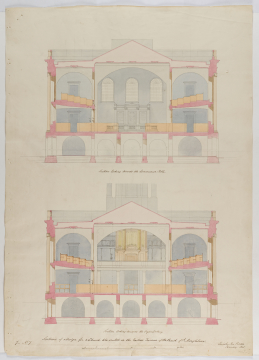
Browse
Reference number
Purpose
Aspect
The section at the bottom shows the vaults, nave and side aisles looking towards the principal (western entrance). The nave adn gallery aisles are divided by a landing and doors are each end. In the aisles at nave level are free seats and box pews extending into the nave, at gallery level are descending sets of pews. Arches span across the aisles and the main gallery level. The nave has box pews and Free seats in the centre, and a colonadde of Doric columns support the organ gallery. Within the organ gallery is the organ and supports for the childrens' gallery. Above is a pitched roof and behind is the first tier of the tower with free-standing columns
Above, the section to the east end of the church is identical to that below, but there are no Free Seats, in front of the arcade of arches is a balustrade for the communion area, and behind is the altarpiece. Above are three arch-topped latticed windows in the rear wal. The roof above is pitched
Scale
Inscribed
Signed and dated
- January 1825
Lincolns Inn Fields. / January. 1825.
Medium and dimensions
Hand
Watermark
Level
Sir John Soane's collection includes some 30,000 architectural, design and topographical drawings which is a very important resource for scholars worldwide. His was the first architect’s collection to attempt to preserve the best in design for the architectural profession in the future, and it did so by assembling as exemplars surviving drawings by great Renaissance masters and by the leading architects in Britain in the 17th and 18th centuries and his near contemporaries such as Sir William Chambers, Robert Adam and George Dance the Younger. These drawings sit side by side with 9,000 drawings in Soane’s own hand or those of the pupils in his office, covering his early work as a student, his time in Italy and the drawings produced in the course of his architectural practice from 1780 until the 1830s.
Browse (via the vertical menu to the left) and search results for Drawings include a mixture of Concise catalogue records – drawn from an outline list of the collection – and fuller records where drawings have been catalogued in more detail (an ongoing process).

